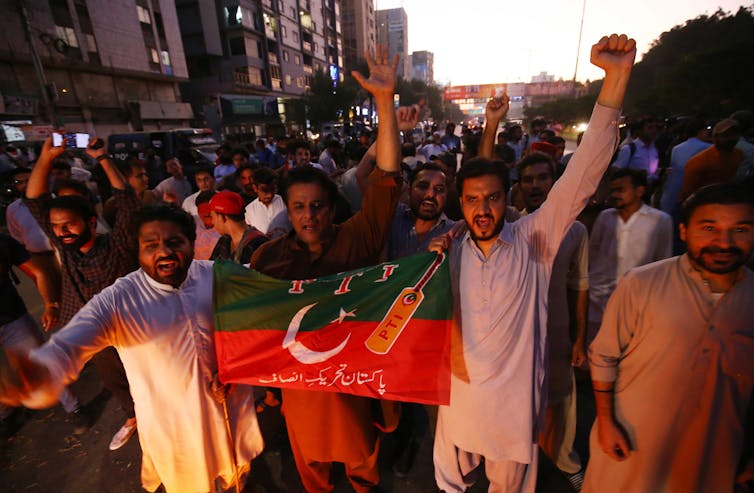Shooting of Imran Khan takes Pakistan into dangerous political waters
- Written by Samina Yasmeen, Director of Centre for Muslim States and Societies, The University of Western Australia

The attempted assassination of Imran Khan on November 3 has ushered Pakistan into another stage of political instability, with increased likelihood of further political violence.
Imran has accused[1] Pakistan’s Prime Minister, Shehbaz Sharif, Interior Minister Sanaullah Khan and Major General Faisal of masterminding the attack. He has demanded these three be removed from their positions immediately. Failure to act, he communicated through Asad Umer[2], a senior member of his party, Pakistan Tehreek-e-Insaf (PTI), would result in demonstrations across the whole country, and “things would not continue as they have been”.
The PTI’s Asad Umer said that two days ago, he had contacted Imran regarding threats to his safety. But Imran had stated: “We are engaged in jihad and we only need to trust Allah at this stage.” Building on this equivalence of the so-called “long march” with “jihad”, the PTI issued a call for demonstrations[3] to start after Friday prayers on November 4.
The Pakistan government has responded[4] by condemning the assassination attempt. But Minister Rana Sanaullah also told the PTI[5]: “It is [a] law of nature: those who ignite fire may also burn in it.” The national government has also demanded “the Punjab government constitute a Joint Investigation Team (JIT) to investigate the attack”.
Others have raised questions about the security extended to the former prime minister in the province of Punjab, where a PTI government is in power.
Conspiracy theories about the shooting also abound, including claims on social media that the attack was orchestrated by PTI[6] to boost support for Imran. Only a few days ago, the former international cricketer turned politician had launched a second march within five months for haqiqi azadi (real freedom). Others accuse “external powers” of fomenting instability in the wake of Prime Minister Shehbaz Sharif’s visit to China[7], where he met President Xi Jinping and revived the momentum for the China-Pakistan Economic Corridor (CPEC).
Read more: What's the dispute between Imran Khan and the Pakistan government about?[8]
Then there is the reported admission[9] by the alleged assassin that he was motivated by religious fervour, as Imran’s march would not cease playing music even during the calls to prayer. Reminiscent of the grounds on which Mumtaz Qadri assassinated[10] the then governor of Punjab Salman Taseer, this explanation, with all its inconsistencies, locates the attempt outside the scope of political machinations.
The reaction among Imran’s supporters has been swift. There have been demonstrations in all provinces of the country, with people chanting the attack[11] had “crossed the red line” and they would lay their lives for Imran. This outpouring of support for Imran and anger towards the government has catapulted the country into increased instability, with the future now very uncertain.
In the past, the instability might have been reined in by the Pakistan military, which has traditionally acted as custodian of law and order in the country. During the 75 years of Pakistan’s existence, the military has intervened directly or indirectly in politics when the country experienced instability. Even if its intervention was not approved of, politicians and society generally remained complacent and managed to work withing the framework outlined by the military.
But in contemporary Pakistan, given the extent of political and social polarisation that has descended to a level not witnessed in the country’s history, the military may not be able to play this role. Already, Chief of Army Staff Qamar Javed Bajwa has claimed the military would remain neutral[12].
Even if instability persists and the military decided to intervene, the reaction of Imran’s supporters would be very different from how people reacted to previous military interventions. The assassination attempt on Imran has removed a lot of self-imposed censorship by people.
Read more: Pakistan: new government must tackle police corruption and killings[13]
While people demonstrated outside the office of the Corps Commander of Peshawar, others have been recorded chanting that the uniform is behind acts of terrorism and hooliganism[14]. In the past, such comments were only openly made by Pashtoon Tahhafuz Movement (movement for the protection of Pashtoons).
But now, such comments also allude to the recent killing[15] in Kenya of Pakistani journalist Ashraf Sharif, who had been a vocal critic of the military’s involvement in politics. It has been claimed the killing was orchestrated with the direct involvement of the military — a claim that prompted the director-general of Inter-Services Intelligence (ISI) to give a press conference refuting these claims.
Such expressions of anger and open opposition to the military leadership would suggest the military would avoid direct interference. One possible avenue could be of imposing governor rule[16] in Punjab and Khyber Pakhtunkhwa, but even that is unlikely to tamper the anger being felt by Imran’s supporters.
Pakistan is fast moving into uncharted political terrain.
References
- ^ has accused (www.bbc.com)
- ^ communicated through Asad Umer (twitter.com)
- ^ call for demonstrations (twitter.com)
- ^ has responded (www.thenews.com.pk)
- ^ Minister Rana Sanaullah also told the PTI (www.thenews.com.pk)
- ^ orchestrated by PTI (twitter.com)
- ^ visit to China (www.aljazeera.com)
- ^ What's the dispute between Imran Khan and the Pakistan government about? (theconversation.com)
- ^ reported admission (www.24newshd.tv)
- ^ assassinated (www.bbc.com)
- ^ chanting the attack (www.youtube.com)
- ^ military would remain neutral (www.news18.com)
- ^ Pakistan: new government must tackle police corruption and killings (theconversation.com)
- ^ the uniform is behind acts of terrorism and hooliganism (www.youtube.com)
- ^ recent killing (www.bbc.com)
- ^ governor rule (www.geo.tv)

















